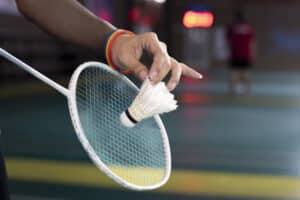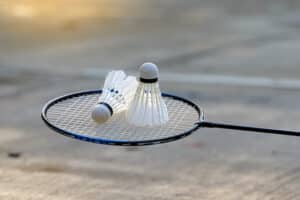How to Mark Out a Badminton Court on Grass
Key Takeaways
- A standard badminton court on grass should be 13.4 meters (44 feet) long and 6.1 meters (20 feet) wide.
- The necessary tools for marking out a badminton court on grass include a measuring tape, stakes, string, a hammer, and a marker.
- The court should be marked with stakes and string, including the perimeter, service lines, centerline, net line, and sidelines.
If you’re a badminton enthusiast looking to enjoy a game in your backyard or a local park, marking out a badminton court on grass is a great option. Playing on grass can provide a unique and enjoyable experience, but it’s important to ensure that the court is properly marked to maintain fairness and accuracy during gameplay.
In this article, we will provide a step-by-step guide on how to mark out a badminton court on grass, based on the information gathered from various sources.
1. Determine the Court Dimensions
The first step in marking out a badminton court on grass is to determine the court dimensions. A standard badminton court is rectangular in shape, measuring 13.4 meters (44 feet) in length and 6.1 meters (20 feet) in width. These dimensions provide adequate space for both singles and doubles play.
2. Gather the Necessary Tools
Before marking out the court, gather the necessary tools and materials. You will need a measuring tape, stakes, string, a hammer, and a marker. Ideally, use a chalk line as it provides a more visible and temporary marking.
3. Mark the Perimeter of the Court
Use stakes and string to mark the perimeter of the court. Measure and mark a rectangle that is 13.4 meters (44 feet) long and 6.1 meters (20 feet) wide. Make sure the lines are straight and properly aligned.
4. Mark the Service Lines
Next, measure and mark the service lines. The short service lines should be 2.13 meters (7 feet) from the back of the court, while the long service lines should be 4.57 meters (15 feet) from the back of the court. These lines indicate the area from which players must serve.
5. Mark the Centerline
Measure and mark the centerline of the court. The centerline should run through the middle of the court and be 2.13 meters (7 feet) wide. This line helps determine the boundaries for doubles play and divides the court into two equal halves.
6. Mark the Net Line
Measure and mark the net line, which should be 0.914 meters (3 feet) from the back of the court. This line indicates the position where the net will be placed.
7. Mark the Sidelines
Measure and mark the sidelines, which should be 0.6 meters (2 feet) from each side of the court. These lines help determine the boundaries for singles play.
8. Mark the Sidelines Again
Measure and mark the sidelines once again, but this time they should be 0.3 meters (1 foot) from each side of the court. These lines provide additional visual cues and help players determine if the shuttlecock is “in” or “out” during gameplay.
9. Make the Lines More Visible
Once all the lines are marked, use a marker to make them more visible. This step is especially important if you’re using a chalk line, as it may fade over time. Making the lines more visible ensures that players can easily identify the boundaries during the game.
10. Set Up the Net and Posts
Place the net at the center of the court, with the top of the net being 0.914 meters (3 feet) from the ground. Make sure the net is properly tensioned and securely fastened. Place the posts of the net at the corners of the court to provide support and stability.
11. Add Shuttles
Place two shuttles at the center of the court, 0.914 meters (3 feet) apart. The shuttles serve as visual markers and can be used to determine the position of the net and the service lines.
Conclusion
Marking out a badminton court on grass is a relatively simple process that requires careful measurement and marking. By following the steps outlined in this article, you can create a properly marked badminton court on grass and enjoy a game of badminton with family and friends.
Related Websites:
FAQs:
Q: Why is badminton a popular recreational sport?
Badminton is popular as a recreational sport due to its accessibility, versatility, and the physical and mental benefits it offers. It can be played by people of all ages and skill levels, making it a great choice for family gatherings, social events, or casual play.
Q: What are the official dimensions of a badminton court?
The official dimensions of a badminton court are 20 feet wide for singles matches and 44 feet wide for doubles matches. The length of the court is 44 feet in both cases.
Q: What materials and tools do I need to mark out a badminton court on grass?
To mark out a badminton court on grass, you will need white paint or chalk, measuring tape or a measuring wheel, stakes or cones, and a long string or rope. If you don’t have access to these specific tools, you can use improvised alternatives like colored tape or natural markers to mark the lines.
Q: How do I select a suitable location for the badminton court?
When selecting a location for the badminton court on grass, look for a flat and level area with enough space to accommodate the official court dimensions. Consider factors like overhead clearance, absence of obstacles, and good drainage. Also, ensure that the location provides adequate sunlight and ventilation for an enjoyable playing experience.
Q: How do I accurately mark the net position and center line on the court?
To mark the net position and center line on the badminton court, measure the center of the court and mark it as the center line. Then, measure the height of the net (5 feet 1 inch for the center) and place markers on both sides of the court. Attach the net to the markers. Ensure the net is taut and at the correct height.






